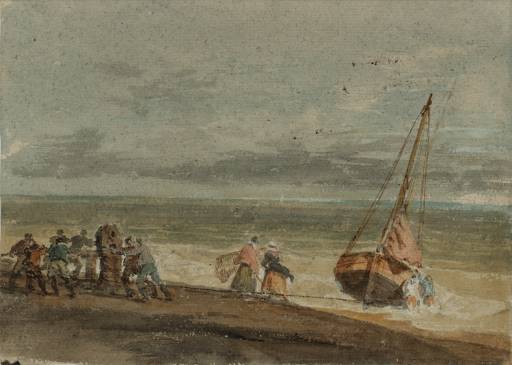Joseph Mallord William Turner Fishermen Hauling a Boat through Surf on a Windlass 1796-7
Joseph Mallord William Turner,
Fishermen Hauling a Boat through Surf on a Windlass
1796-7
Joseph Mallord William Turner 1775–1851
Fishermen Hauling a Boat through Surf on a Windlass 1796–7
D00888
Turner Bequest XXXIII Q
Turner Bequest XXXIII Q
Pencil, watercolour and gouache on coarse buff laid paper, 194 x 269 mm
Blind-stamped with Turner Bequest monogram bottom left
Stamped in black ‘XXXIII – Q’ bottom right
Blind-stamped with Turner Bequest monogram bottom left
Stamped in black ‘XXXIII – Q’ bottom right
Accepted by the nation as part of the Turner Bequest 1856
Exhibition history
1904
National Gallery, London, various dates to at least 1904 (726, as ‘Fishing-Boat’).
1949
British Painting from Hogarth to Turner, British Council tour, Kunsthalle, Hamburg, Kunsternernes Hus, Oslo, Nationalmuseum, Stockholm, Statens Museum for Kunst, Copenhagen, 1949–50 (105).
1952
Watercolours from the Turner Bequest [Loan Series D], County Borough of Swansea Art Galleries, October–December 1952 (no catalogue).
1988
Young Turner: Early Work to 1800: Watercolours and Drawings from the Turner Bequest 1787–1800, Tate Gallery, London, January–March 1988 (19, reproduced).
References
1904
E.T. Cook and Alexander Wedderburn eds., Library Edition: The Works of John Ruskin: Volume XIII: Turner: The Harbours of England; Catalogues and Notes, London 1904, p.640 no.726, as ‘Fishing-Boat’.
1909
A.J. Finberg, A Complete Inventory of the Drawings of the Turner Bequest, London 1909, vol.I, p.67, XXXIII Q, as ‘Men at Windlass drawing fishing boat out of surf’. c.1796–7.
1920
D[ugald] S[utherland] MacColl, National Gallery, Millbank: Catalogue: Turner Collection, London 1920, p.50.
1989
Anne Lyles, Young Turner: Early Work to 1800: Watercolours and Drawings from the Turner Bequest 1787–1800, exhibition catalogue, Tate Gallery, London 1989, p.29 no.19, reproduced.
Technique and condition
This is a composition in watercolour, pencil and gouache on a flecked brown, laid wrapping paper made with a single faced mould. There is no watermark and the image is painted on the felt side of the sheet. The chain lines are 227–8 mm (variable) apart and there are 7 laid lines per centimetre.1
The watercolour is rather thickly painted. Beneath the paint there is a detailed graphite pencil sketch of the composition. The entire paper is covered with dense washes and no blank areas have been left. There is very little building up of layers in the composition. Turner used a range of different brush sizes (or brush edges) to create the paint effects in this image.
In the X-radiograph of the paper a spot of thick brown pigment on the back of the paper shows up as a white patch on the front, indicating that it is a thick application of earth colour. The gouache was made from lead white, as the X-radiograph confirms: lead white is dense and heavy, and each brush-stroke shows up clearly as the brightest white in the image. This was Turner’s usual choice for gouache at in early decades, though it would have been more common at this time to use chalk instead, which gives a fairly dense gouache that would not be subject to colour change. Some brush-marks of the lead white are still very prominent in both the sky and on the sunlit shore. However, many are less prominent in the sky now because they have considerably darkened over time and no longer act as highlights; this darkening is caused by hydrogen sulphide in the air. It was a common urban pollutant in Turner's era, when horses powered city transport was common, and sewage disposal was less organised than today.
The figures (painted in true watercolour) show up poorly in the X-radiograph, except for the woman’s shawl, which is clearly visible and must therefore have been much lighter in tone originally.
For the image, black, mixed with one or two ochres, was used to create a variety of different browns. Other pigments that were used include: brownish red and red lakes, indigo (probably), and yellow ochre.
Helen Evans
October 2008
Revised by Joyce Townsend
February 2011
How to cite
Helen Evans, 'Technique and Condition', October 2008, revised by Joyce Townsend, February 2011, in Andrew Wilton, ‘Fishermen Hauling a Boat through Surf on a Windlass 1796–7 by Joseph Mallord William Turner’, catalogue entry, January 2013, in David Blayney Brown (ed.), J.M.W. Turner: Sketchbooks, Drawings and Watercolours, Tate Research Publication, November 2014, https://wwwLike other marine works in this subsection (see the Introduction), this was perhaps drawn at Margate.
Verso:
Blank; inscribed in later hands ‘10’ and ‘15’ (compare verso of Tate D00887; Turner Bequest XXXIII P), and stamped in brown ink with Turner Bequest monogram.
Andrew Wilton
January 2013
How to cite
Andrew Wilton, ‘Fishermen Hauling a Boat through Surf on a Windlass 1796–7 by Joseph Mallord William Turner’, catalogue entry, January 2013, in David Blayney Brown (ed.), J.M.W. Turner: Sketchbooks, Drawings and Watercolours, Tate Research Publication, November 2014, https://www

